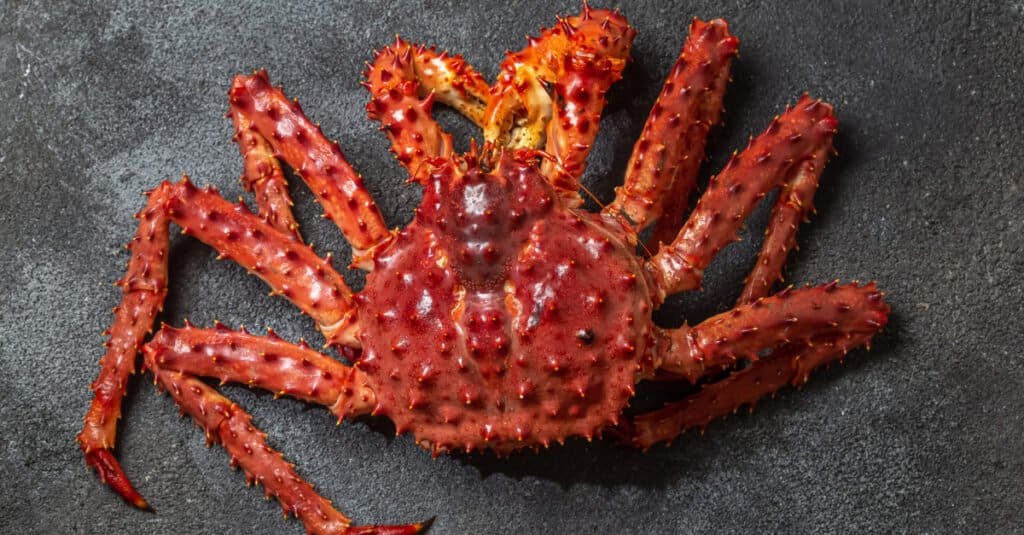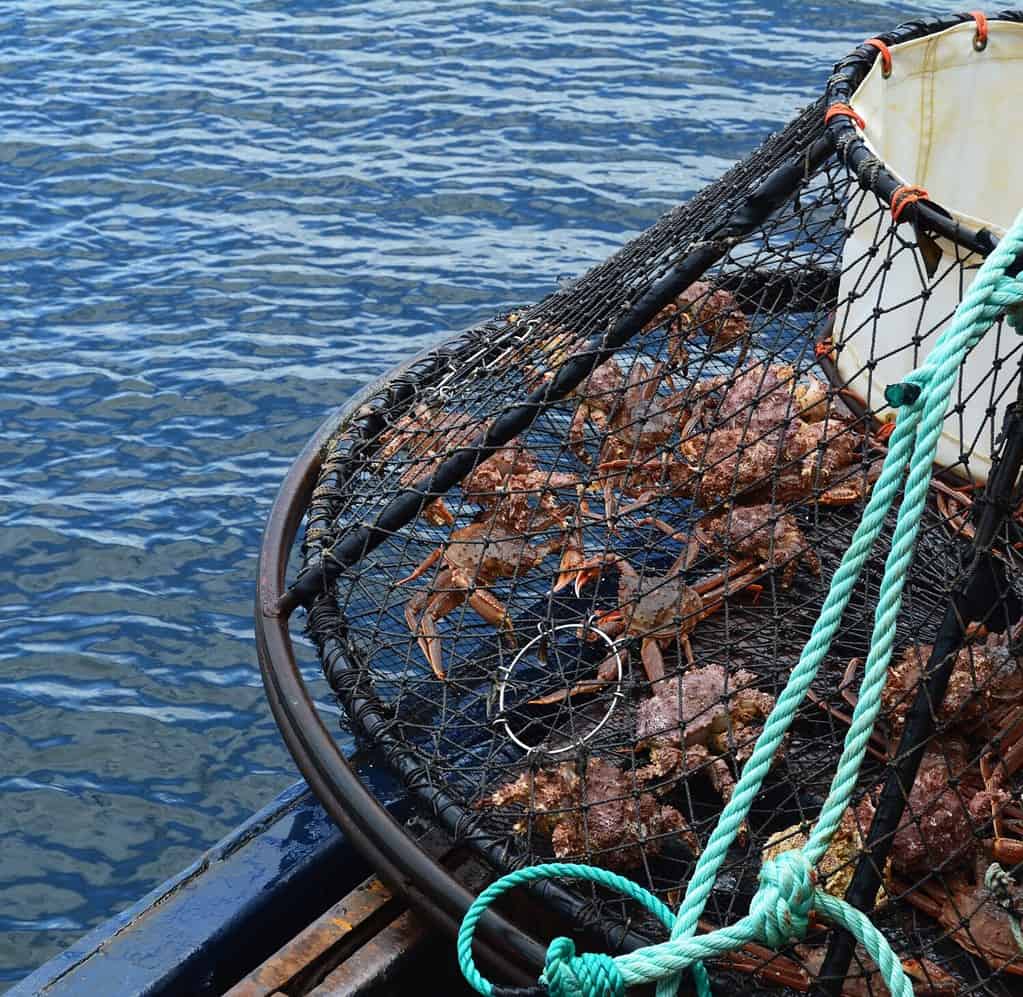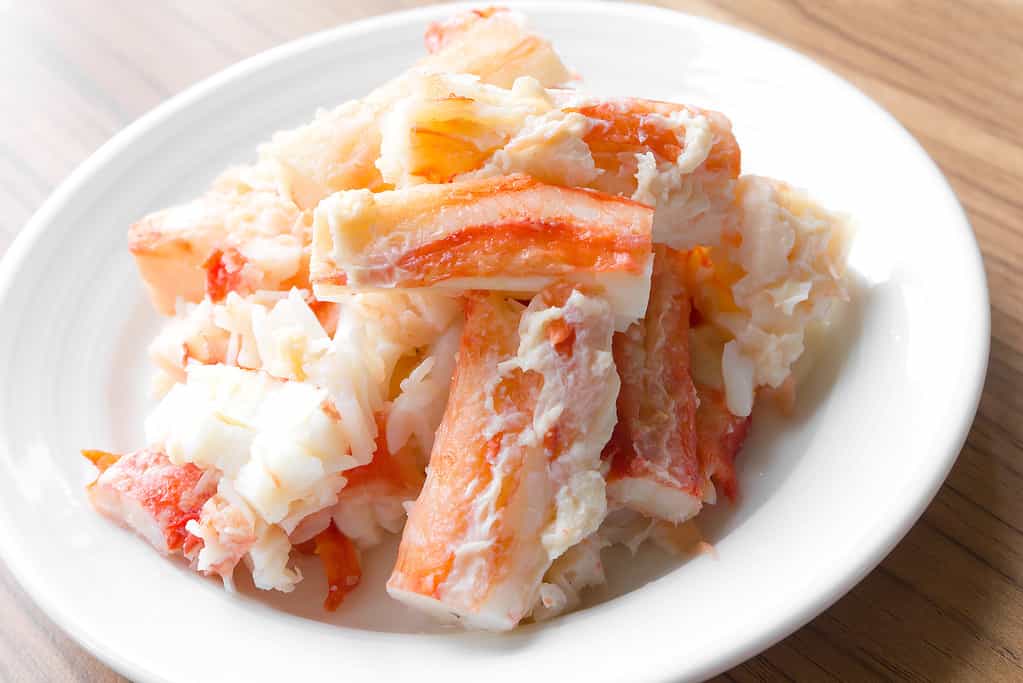A highly prized meat in fish markets and fine dining restaurants the world over, king crab has become world famous for its sweet, juicy meat. The fresh crab, of course, calls for higher prices than frozen, but even frozen king crab meat can fetch a pretty penny both in and out of season. If you’re wondering what king crab market prices are this year as we head into crabbing season, you’ve come to the right place. Let’s take a look at see what you can grab one of these beauties for.
Types of King Crab

The large king crab offers some of the sweetest, most flavorful crab meat in the world. Come find out what to expect when buying in 2024.
©Larisa Blinova/Shutterstock.com
Red King Crab
Caught off Norton Sound and Bristol Bay, red king crab is the most prized of the species. A strong demand for these crabs comes from Europe, the United States, and Japan, in particular. The Alaskan crabs are the largest of the kings and come in a deep burgundy color while living. When cooked, they turn from scarlet red to snow white meat with hints of bright red.
Blue King Crab
Known for its sweet meat and proportionately huge claws, blue king crab from Alaska St. Matthew and Pribilof Islands are favored among chefs and crab fans all over. The crabs are large, with some weighing in as much as 18 pounds on occasion. The crabs turn bright orange-red when cooked. They’re typically marketed as red king crab in the United States, though, because of their cooked coloration. The flavor is similar to red, though a bit sweeter and milder.
Golden or Brown King Crab
The smallest of the three most common king crab species is the golden or brown king crab. These have golden to orange shells and a mild flavor. They commercially are harvested in Alaska and tend to cost the least because of their abundance and the lower quality of the meat.
Scarlet King Crab
Not as viable on the commercial market, the scarlet king crab of the Bering Sea is the fourth variety in the category. The meat is supposedly extremely sweet but the crab does not come in a large enough population or animal size for a sustainable commercial market.
When Is King Crab Season?

Alaska’s economy depends heavily on the fishing of king crab. King crab season hits during the coldest months of the year, making the industry a hard one to work in.
©Vintagepix/Shutterstock.com
Three varieties of king crab are fished for most commonly. Golden king crab, or brown king crab, is caught throughout the year, though February to June is its peak season. Red and Blue Alaskan king crab may only be fished between November and January.
Prime king crab, whichever type, is caught during cold months, generally between October and January. It may begin a little sooner any given year or extend longer, fully dependent on the weather and how cold it gets. These crabs are primarily only caught in Alaska which does, indeed, have seasons, meaning the season is highly dependent on the season changes there.
What Are the King Crab Market Prices in 2024?
At the start of 2024, the retail king crab market prices are between $13 and $24 per kilogram or $5.90 to $10.88 per pound. Wholesale king crab market prices drop as folks purchase this in bulk. These prices range from $9.10 to $16.8 per kilogram or $4.13 to $7.62 per pound.
Variation In King Crab Costs
As you look around for king crab, you’ll likely notice a good bit of variation in prices. Many things can influence these costs, but most likely these will do it.
- Location: King crab prices vary by location of catch and if anything has been imported into the area.
- Season: When king crab is in season, prices may be lower because more crabs are available for sale and demand is lower. Off-season prices often skyrocket because there are fewer crabs available.
- Size or grade: Grades are assigned to crabs by the number of legs, the specific weight, and other similar factors. The higher the grade, the higher the price.
- Market demand: Overall demand for king crab also affects the price. Preferences from consumers, as well as worldwide events (COVID pandemic or wars, for example), can impact this demand.
Best King Crab Recipes

Succulent and sweet, king crab meat favor reflects in the market prices of 2024. The highly sought after meat tends to be a hit pricey but folks who love it say it’s well worth the price.
©simmax/Shutterstock.com
If you search online, you’ll find many tasty ways to prepare your king crab. Some of the best recipes include:
- Baked king crab
- Baked king crab with garlic butter
- Classic king crab
- King crab dip
- Homemade Cajun seafood boil
- Avocado crab cake sliders
- King crab scampi
Is King Crab Good for Your Health?
Like everything else you eat, king crab should be eaten in moderation. But when you do so, you’ll find that several nutrients make this flavorful special meal a healthy treat.
- King crab is high in Vitamin B12. This nutrient helps keep nerves and blood cells healthy. In just 3 ounces of king crab, you’ll receive 160 percent of the daily recommended value of B12.
- The meat is low in fat but high in protein. That means king crab offers lean (animal) protein, which we should all focus on in our eating habits. This also ranks higher in satiety value than many other proteins. Each serving of king crab offers 1 gram of fat, 82 calories total, and 16 of those are protein.
- King crab is also high in Omega-3 fatty acids. This is the right kind of fat for a healthy diet. These amino acids help reduce inflammation, ward off chronic illness, and strengthen the heart.
- You’ll get plenty of zinc, copper, and selenium when you eat king crab. The crustacean offers these necessary nutrients in fairly high doses that help your immune system and bones. Plus, these aid in collagen production and iron absorption.
- King crab contains phosphorous for healthy, natural detoxification in the body. This means support for your liver and kidney function, which removes toxins from your body.
The photo featured at the top of this post is © simmax/Shutterstock.com
Thank you for reading! Have some feedback for us? Contact the AZ Animals editorial team.







